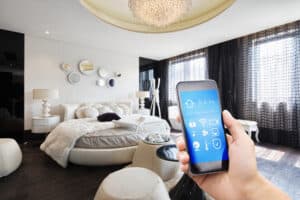
Moving into a first home is a milestone for many graduates. Between rent deposits, furniture and everyday bills, the costs quickly add up.
In this context, smart technology is increasingly being seen not as an extravagance but as a way to manage expenses, improve comfort and adapt to new patterns of working life.
Smart home devices have developed far beyond their early reputation as luxury add-ons. A decade ago, automation was the preserve of high-end properties, often requiring specialist wiring and bespoke design. Today, the technology is far more flexible. Entry-level devices such as smart plugs, light bulbs and thermostats can be installed without major alterations, making them suitable even for small rented flats or shared student houses.
Market data suggests this shift is accelerating. The UK smart home sector is projected to generate more than £9 billion by 2028, with annual growth above 12 per cent. Energy management is expected to be the leading driver, reflecting both rising utility costs and growing interest in sustainability. According to Energy Saving Trust, a smart thermostat can cut heating bills by up to £75 a year, while smart lighting systems can save 15 per cent compared with traditional bulbs.
The cost of automation is often less straightforward than people expect. According to how much a smart home costs in the UK, prices can range from modest starter setups to comprehensive whole-home installations. For graduates, this flexibility is key. A single connected thermostat might cost around £200, while a basic starter kit of smart bulbs can be purchased for less than £50. The modular nature of the technology means new features can be added over time, spreading costs and avoiding large upfront commitments.
Convenience remains one of the strongest appeals. A smart thermostat can be adjusted remotely from a phone, ensuring the heating is only on when it is needed. Connected lighting makes it easy to create comfortable study environments or save energy when nobody is home. Voice assistants are increasingly common in shared living spaces, offering a hands-free way to control music, lighting and reminders. For renters, portable devices that can move easily between properties are especially attractive.
Security has also become a growing consideration. Video doorbells, connected locks and motion sensors provide reassurance in busy urban areas and can help protect packages or bicycles kept outside. For those away from home during university holidays or internships, the ability to monitor a property remotely adds an extra layer of confidence.
Entertainment is another driver of adoption. Smart speakers and streaming devices have transformed the way students and young professionals consume media, offering cinema-style experiences in living rooms without the need for expensive equipment. As costs fall further, integrated systems that combine lighting, sound and display are expected to become more mainstream.
Looking ahead, the role of smart homes is likely to expand further. Advances in artificial intelligence will make automation more predictive, adjusting lighting, heating and even appliance use based on patterns of behaviour. The growth of electric vehicles is also expected to connect more directly with domestic energy management, with homes using automation to balance charging needs against renewable supply.
Technology that was once confined to luxury estates is now woven into everyday life for students and graduates. As devices continue to become more affordable and energy efficiency becomes a national priority, smart systems are likely to be viewed as a standard part of setting up a home. For graduates starting out, even a modest investment in connected devices can provide immediate convenience and long-term savings.
Read more:
How to set up a smart home on a budget after graduation

